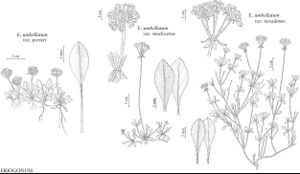Difference between revisions of "Eriogonum umbellatum var. porteri"
Eriogonum, 109. 1936.
FNA>Volume Importer |
FNA>Volume Importer |
(No difference)
| |
Revision as of 22:37, 16 December 2019
Herbs, prostrate, cespitose mats, 0.2–0.6 × 1–5 dm. Aerial flowering stems erect or nearly so, 0.1–0.5 dm, floccose to nearly glabrous, without one or more leaflike bracts ca. midlength. Leaves in tight rosettes; blade usually elliptic to spatulate, 0.4–1.1 × 0.3–0.8 cm, glabrous on both surfaces, margins plane. Inflorescences umbellate and subcapitate or capitate; branches shorter than 0.5 cm, without a whorl of bracts ca. midlength; involucral tubes 2–3 mm, lobes 2–3 mm. Flowers 3–6 mm; perianth bright yellow.
Phenology: Flowering Jul–Sep.
Habitat: Rocky slopes and ridges, high-elevation sagebrush and meadow communities, subalpine to alpine conifer woodlands
Elevation: (2400-)2700-3700 m
Distribution

Colo., Nev., Utah.
Discussion
Variety porteri is a high-elevation counterpart of var. aureum that may not be worthy of taxonomic recognition. At their extremes, the two are markedly distinct, and based on limited observations of cultivated plants, each maintains its basic habit when grown under uniform conditions. In Nevada (Elko, Lander, and Nye counties), var. porteri grows with a similarly reduced alpine expression of the cream-colored var. desereticum. Elsewhere it is widely scattered, mainly in the Uinta and Wasatch mountains of Utah (Beaver, Duchesne, Iron, Piute, Salt Lake, Sevier, Summit, Uintah, Utah, and Wasatch counties), as well as in the Colorado Rocky Mountains (Chaffee, Delta, Gunnison, La Plata, Moffat, and Pitkin counties). A collection supposedly gathered near the Goodman Ranch in Uinta County, Wyoming (Payson 4920, DS, RM, S, UTC), is almost certainly mislabeled. The variety is occasionally seen in cultivation, mainly in Europe.
Selected References
None.
